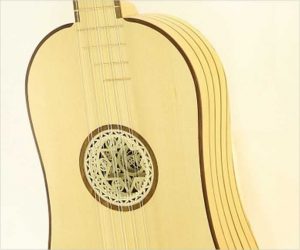The Roosebeck 5-course Baroque guitar is based on historic instruments, and is built using materials not covered by CITES export restrictions. The top is Spruce, the body and neck are a combination of light-coloured Lacewood and darker Sheesham. Lacewood is a term used for a variety of woods but often Roupala Brasiliensis, while Sheesham is Dalbergia Sissoo, also known as North Indian Rosewood. On some versions of this instrument, Mid-East has used Walnut in place of Sheesham.
Bowl Back
This Roosebeck Renaissance lute is a 6 course model, featuring a bowl constructed of 25 fluted Sheesham staves, and with a 600mm scale length. The top is Spruce, while the neck, bowl, nut, bridge, and end pin are built of Sheesham, The peg box is Sheesham and Lacewood. The frets are formed in the traditional manner – tied on – but are nylon line (guitar string) rather than gut.
Here we have an Albert J Litto 7 Course Renaissance Lute, built during 1965 in Kenmore, New York. This lovely Renaissance lute demonstrates many traditional construction techniques. The bowl back is composed of flamed maple ribs, bent and joined. Inside the bowl, the ribs are sealed with parchment tape, made wet to induce expansion, then coated with hide glue. The water on the inside forces the ribs to curve from side to side, and the hardening glue keeps them in this shape.
This instrument has sold
MORE →Popular during the 19th and into the mid-20th century, the Greek Laouto or lute contributed to the evolution of the now popular Greek Bouzouki. Though similar in many ways to the German lute guitar, the Greek instrument is strung with double gut or nylon strings in a variety of tunings similar to Bouzouki tunings. The role of the Laouto was usually as a backup instrument to a violin of bouzouki. The frets are tied on as on a Renaissance Lute. The tops were generally spruce and the back are bowl-back construction consisting of 20 or more ribs similar to a Renaissance lute
This instrument has sold
MORE →




